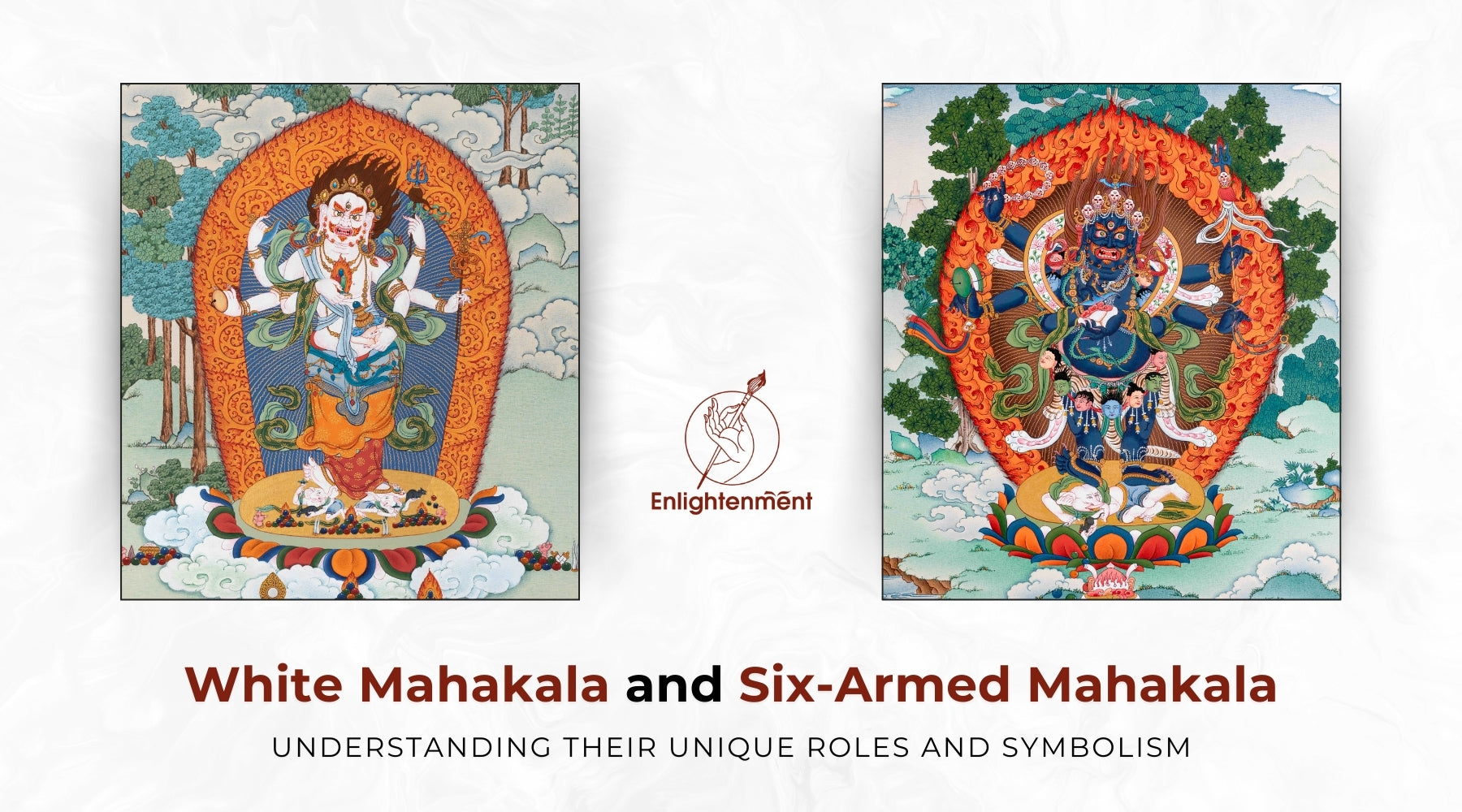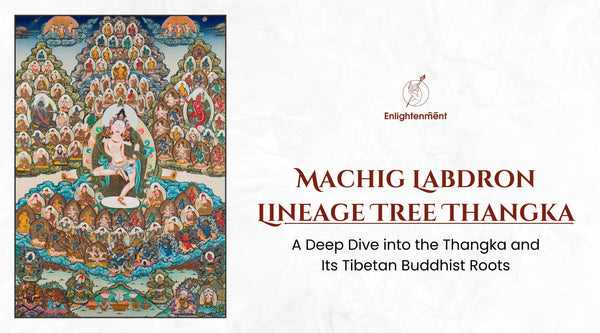Who is Mahakala?
Mahakala are protected deities in the sect of Buddhism. There are many Mahakalas, also known as Dharmapala, the protector of the dharma. They protect the dharma and the followers of dharma. It is said that they were potent spirits tamed by Buddha and other heavenly beings to work as a protector and do something good with their immense power rather than using them incorrectly. In other cases, Mahakalas are wrathful forms of peaceful deities. For instance, white Mahakala and 6-arm Mahakala emanation of Avalokiteshvara, the bodhisattva of compassion. Each has its specialty, one being the main wealth deity and another being the main protector of Kagyu School.
In this blog, we will study both mahakalas in depth. Scrutinize their roles and even how to worship those two profound emination. Furthermore, We’ll also find out how the six-armed deities are different.
Role as a Fierce Protector
In Tibetan monasteries, there are a plethora of thangkas painted on walls and canvas, and some even have statues. They are regarded as the protector deity, protecting their dharma, practitioner, and religion. While safeguarding us believers, they also help us overcome obstacles and lead toward enlightenment. They have very fearful eyes and fangs in general, but they are not meant to scare us but to remind us to eliminate ignorance and ego-controlled actions.
White Mahakala, Symbolism, and Role

Appearance of White Mahakala
Numerous mahakalas have black or blue as their body colors. However, the white mahakala, also identified as Shadbhuja Sita Mahakala, stands out in its snowy white body color. The bright white color represents purity, compassion, and his proficiency to cleanse negative karma. He is often shown with one head, six arms similar to the other six-arm Mahakala, one pair of legs and two elephants underneath them, and a crown adorned with gems, not skulls like other Mahakala.
Role as a Wealth Deity
White Mahakala is practiced in many buddhism schools for weath-related pujas. But it's not merely about the accumulation of wealth or material, but it is about spiritual development - as considered in Tibetan buddhism. However, if one has enough for oneself and his family, then it will be a lot easier to indulge in dharma activities. So, the white mahakala also helps devotees gain abundance and prosperity. Furthermore, providing the practitioner with a sense of protection as wealth and other fulfillment attract other unnecessary guests. Therefore, Sadbuja Sita Mahakala has the role of prosperity provider in terms of wealth and spirituality and protecting the practitioner.
In numerous lineages, White Mahakala is mainly involved during prayers of wealth generation or helping one with financial obstacles or resourcefulness. As his blessings are considered so powerful, they sought to remove any hindrance with wealth accumulation, reduce debts, and create suitable circumstances for prosperity.
Symbolism of Compassion and Purification
Like the compassionate lord Avalokiteshvara at White Mahakala’s core, sympathy and love flow in a more wrathful form as he is manifested. The wrath of Mahakala eradicates the external and inter blockage, which hinders compassion and resourcefulness. His bright white color signifies cleansing, showing that even the dirtiest karmic pigment can be purified through devotion.
Six-Armed Mahakala: Symbolism and Role
Check out our Six-armed Mahakala, which is made of 100% natural mineral colors.
The appearance of Six-Armed Mahakala
The Six-Armed Mahakala is one of Tibetan Buddhism's most commonly depicted forms of Mahakala. As his name suggests, he has six arms, each wielding a different spiritual resource, such as a Kartika (flaying knife), kapala (skull cup), and other symbolic weapons. He usually has one head & two legs, stamping on one elephant, crowned decorated with five skulls, and a fierce expression with fangs and fiery eyes. This terrifying iconography illustrates his power to destroy delusion and negative energies. And not to generate fear near us naive beings.
Role as a Fierce Protector
While White Mahakala retains prosperity, the Six-Armed Mahakala is notably a Dharmapala who works to eliminate internal obstacles (like ignorance and attachment) and external obstacles (such as evil forces). He is always present to protect the teachings of the Buddha and practitioners. The six arms show his swiftness and capability in confronting all forms of negative energy, whether from personal afflictions or external challenges.
The symbolism of Overcoming Inner and Outer Obstacles
Each of the Six-Armed Mahakala’s weapons holds deep symbolic meaning:
-
Kartika (Flaying Knife) & Kapala (Skull Cup): Cuts away ego and harmful attachments and Represents the transformation of negative emotions into nectar of wisdom

-
Damaru (Hand Drum): Calls upon enlightened activities and awakens higher awareness

-
Trident or Khatvanga: Points to the union of emptiness, compassion, and bliss.

-
Rosary or Mala: Symbolizes constant mindfulness and the recitation of mantras.

-
Lasso: It captures enemies, harmful forces, and internal forces like ignorance, greed, and hatred.

By incorporating these six functions, Six-Armed Mahakala is a potent force against all obstacles that hinder spiritual progress.
Key Differences Between White Mahakala and Six-Armed Mahakala

Below is a brief comparison of these two prominent forms of Mahakala:
|
Aspect |
White Mahakala |
Six-Armed Mahakala |
|
Appearance |
White body, Stands upon two elephants |
Blue body, Stands upon One elephant |
|
Primary Role |
Wealth deity and bringer of prosperity |
Fierce protector and destroyer of negativity |
|
Symbolism |
Compassion, purification, abundance |
Overcoming inner and outer obstacles, wrathful compassion |
|
Legends & Stories |
Prosperity blessings |
Safeguarding the Dharma |
|
Worship Focus |
Material and spiritual abundance |
Protection from obstacles, both internal and external |
|
Typical Rituals |
Prosperity rituals, offerings of tormas, incense |
Defensive rituals, fire pujas, wrathful mantras |
By examining this table, it’s clear that while both forms share Mahakala’s fierce compassion and protective energy, White Mahakala specializes in generating auspicious conditions for wealth and spiritual progress. In contrast, the Six-Armed Mahakala is adept at defeating negative forces.
How to Worship Mahakala

Check our High-Quality White Mahakala Thangka Print
Practical Tips for Worship
-
Create a Sacred Place: Create a small altar with images or manifestations of either White Mahakala or Six-Armed Mahakala (or both). A disorderly place won't help your spirituality, so it should be clean.
-
Offerings: Torma (also known as flour cakes), flowers, incense, water, and fruits are standard offerings. Wealth symbols were added to White Mahakala. For instance, rice or coins could increase wealth. For Six-Armed Mahakala, offerings such as incense represent protection and strength, and black sesame seeds may be used.
-
Incense and Butter Lamps: Light incense sticks or burn loose incense to purify the surroundings. Butter lamps or candles represent the dispelling of darkness through the light of wisdom.
-
Mantra Recitation: Each Mahakala form has its specific mantras. Repetition of these mantras while holding a mala (rosary) can deepen your connection to the deity.
Step-by-Step Guide for Beginners
-
How to Do It: Get somewhere quiet and pull your posture comfortably. Light a candle or butter lamp and for incense.
-
Take Refuge and Generate Bodhicitta: Recite words of taking refuge in the Three Jewels (Buddha, Dharma, and Sangha) and generate bodhicitta (the wish to attain enlightenment for sentient beings).
-
Visualize Mahakala: Imagine White Mahakala if focusing on prosperity or a Six-Armed Mahakala if seeking protection, manifesting before you.
-
Mantra Recitation: Chant the Related Mantra. A popular mantra for White Mahakala is “ OM GURU MAHAKALA HARI NI SA SIDDHI DZA”. In contrast, a common mantra for Six-Armed Mahakala is “OM BENZA NARA TRIM TRIM HUNG HUNG PHET PHET SOHA.” Say it a minimum of 21 times or more. It's best if you use a mala to count.
-
Offerings: Give gifts like water bowls, incense, or flowers.
-
Absorption: End your practice by picturing Mahakala melting into your heart. This stands for blending his enlightened traits with yours. To wrap up, dedicate the good karma from your practice to helping all living creatures.
Following these steps can deepen your relationship with Mahakala and invite his transformative power into your life.
However, the mantra might differ from lineage to lineage, so it is good to check with your lineage's higher lamas or rinpoches before practicing it.
Embrace the Fierce Compassion of Mahakala
In his White or Six-Armed form, Mahakala shows fierce compassion to help people overcome the many obstacles they face on their spiritual journey. White Mahakala brings wealth and cleansing, assisting followers in getting the money they need to go deeper into their Dharma practice. Six-Armed Mahakala protects people fighting against bad things to keep Buddhist teachings safe and look after those who follow them. You can use their power to change your life when you learn what these forms mean, what they do, and how to worship them. This applies whether you want more money, protection, or a deeper spiritual life.
#Disclaminar Although it is easy to start the practice, you should always consult with a higher-ranking lama or Rinpoche to instruct you properly. Improper practice may do more harm than good.



